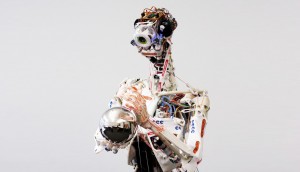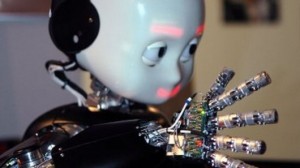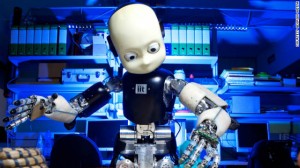Facts About Robots
Robots that only do what they are programmed to do are so 20th century. Roboticists, neuroscientists and psychologists are making great progress in creating independent-minded robots that, like small children, learn by using their bodies and through interaction with humans.
The small creature looks curiously at its hand, which the teacher is moving in a circular motion. It watches intently as the oatmeal from the package pours into a bowl on the table. And it carefully studies how the teacher moves its hand back to the initial position.
Now it must go through the exercise on its own. In a slightly hesitant yet clearly focused motion, the insecure toddler uses its hand to turn over the oatmeal package, sprinkles the oatmeal into the bowl, and moves its hand back. The red mouth lights up the small face. The iCub robot has just learned a new trick.
 One of the robots of the future, the iCub has been created in our image. Like small children exploring the world, who proceed by trial and error and learn from playing games, these pint-size robots are expected to learn how to perform a new task without requiring a program that describes in meticulous detail how to accomplish it. So they’ve been equipped with humanlike bodies and qualities such as curiosity, which should enable them to interact naturally with their surroundings, much in the way a human would — for example, by being shown a ball, moving toward it, picking it up, feeling its texture, placing it on top of another ball and then discovering what happens next.
One of the robots of the future, the iCub has been created in our image. Like small children exploring the world, who proceed by trial and error and learn from playing games, these pint-size robots are expected to learn how to perform a new task without requiring a program that describes in meticulous detail how to accomplish it. So they’ve been equipped with humanlike bodies and qualities such as curiosity, which should enable them to interact naturally with their surroundings, much in the way a human would — for example, by being shown a ball, moving toward it, picking it up, feeling its texture, placing it on top of another ball and then discovering what happens next.
This hypothesis is called “embodied cognition,” and it’s based on the concept that, in order to develop and learn, the human brain depends on the information that it gets from all of our muscles and senses. This means that our senses play a vital role in our ability to understand and function in the world. The theory maintains that only when we physically experience something that we are attempting to learn can we develop an understanding of an abstract concept, such as gravity, or the meanings behind words. Thus, our ability to perform complex actions such as riding a bike or playing the piano also can only be developed by having our bodies repeat the same motions over and over again.
Mimicking the human body
 There are different versions of the next-generation robots, but they all resemble humans — and not just on the surface. One of the most sophisticated of these, the ECCE Robot, is the result of a cooperative effort between a French company, the Robot Studio, and leading technical universities in England, Germany, Switzerland and Serbia. The robot is a near-complete replica of the human body, with polymer bones and artificial muscles that pull tendons made of kite line, which enable it to move its arms, legs and fingers just like we do.
There are different versions of the next-generation robots, but they all resemble humans — and not just on the surface. One of the most sophisticated of these, the ECCE Robot, is the result of a cooperative effort between a French company, the Robot Studio, and leading technical universities in England, Germany, Switzerland and Serbia. The robot is a near-complete replica of the human body, with polymer bones and artificial muscles that pull tendons made of kite line, which enable it to move its arms, legs and fingers just like we do.
When copying humans, a seemingly simple motion such as raising a hand suddenly becomes quite complicated, requiring a coordinated effort from the wrist, elbow and shoulder. An ordinary robot doesn’t need to perform such a nuanced motion, but the new crop of robots must be able to refine their movements, both to ensure the safety of humans — so that, for example, a handshake will not crush the recipient’s hand — and to give the robot the opportunity to learn how its body works by allowing it to act intuitively and naturally. If it stumbles and falls forward, ideally it can learn to use its body to prevent the fall by moving its arms backward, just like a human would, to stabilize its center of gravity.
Mimicking the human mind
 Scientists also expect a lot from the small iCub robot. It was invented by scientists at the Italian Institute of Technology in Genoa with funding from the European Union, and all iCub researchers are making their results available to anyone who would like to use them. So far, more than 20 laboratories, from Europe, the United States and Hirkey, are participating in the project.
Scientists also expect a lot from the small iCub robot. It was invented by scientists at the Italian Institute of Technology in Genoa with funding from the European Union, and all iCub researchers are making their results available to anyone who would like to use them. So far, more than 20 laboratories, from Europe, the United States and Hirkey, are participating in the project.
The iCub’s physical appearance is humanlike, but in general it looks more like a traditional robot. Mentally, however, it functions almost like a human child. It’s equipped with a number of basic human qualities that make learning easier. One is natural curiosity, which gives the robot the urge to take things apart and put them back together again in order to learn how they work and how they can be used. The robot is also able to generalize after playing with an object, which allows it to understand, for example, that a small red ball can be used for almost the same purposes as a big blue ball.
For humans, perhaps the iCub’s most important feature is its facial expression. Two luminous eyebrows and a mouth capable of smiling may not seem like much, but they’re almost enough to make everyone forget that it’s just a robot trying to learn how to become more human.
Facts about iCub Robot
 Standing 41 inches tall and weighing 48 1/2 pounds, the iCub is the same size as a 3-year-old child. It can learn to talk and comprehend an order. It also learns by playing with its arms, hands, legs and feet.
Standing 41 inches tall and weighing 48 1/2 pounds, the iCub is the same size as a 3-year-old child. It can learn to talk and comprehend an order. It also learns by playing with its arms, hands, legs and feet.
THE HEAD CAN MOVE FREELY in all three directions. Its eyes consist of video cameras with a resolution of 640×480. Red LEDs can be activated to indicate the eyebrows and mouth and simulate facial expressions.
MICSON BOTH SIDES OF THE HEAD capture sounds, allowing the iCub to react to spoken commands.
THE UPPERARMS ARE ATTACHED to a shoulder that can rotate while a motor pulls a tendon, making the arm move up or down. A motor is used to bend the elbow joint.
THE ENTIRE TORSO IS ONE UNIT mounted on the hips at a single joint that can not only rotate, but also bend sideways, as well as backward and forward.
THE HANDS ARE CONTROLLED by seven motors in the forearm, used for pulling tendons, plus two motors in the hand. All fingers except the pinky and ring fingers can be moved separately.
53 DIFFERENT MOTORS directly or indirectly make the joints and muscles move. The tendons are cables encased in Teflon-coated steel tubes, like the gear cable of a bicycle.
THE SKELETON is primarily made of aluminium alloy and steel; its parts are designed for optimal functionality and thus don’t resemble human bones.
TACTILE SENSE WILL BE EMBEDDED in the fingertips and other body parts in the form of a touch-sensitive “skin.”This will allow the iCub to determine if a particular object is hard or soft and how hard to grip it.
Facts about ECCE Robot
 The ECCE Robot has a life-size torso that features a skeleton and muscles copied straight from humans, down to the last detail. Just as our bodies relax when we sleep, the ECCE Robot collapses when it is turned off.
The ECCE Robot has a life-size torso that features a skeleton and muscles copied straight from humans, down to the last detail. Just as our bodies relax when we sleep, the ECCE Robot collapses when it is turned off.
A BALL JOINT connects the humerus to the shoulder blade, which is attached to the collarbone by artificial muscles.
THE HEAD’S MAIN FEATURE is the eye, an HD camera with a 90-degree perspective. Its built-in computer quickly identifies the most important elements of the visual field before the information is processed by a larger computer.
MICSON BOTH SIDES OF THE HEAD capture sounds and speech from the surroundings, enabling the robot to react to spoken commands.
THE FLEXIBLE WRIST is controlled by two “muscles, “allowing ” the hand to move sideways and up and down. The finger joints can be bent, but all of the fingers are controlled by the same muscle and can only be moved together.
TOUCH-SENSITIVE SENSORS mounted on its fingertips and palms allow the ECCE Robot to sense what it is touching. Other — parts of its body have electronic accelerometers that can register shocks and vibrations.
80 MUSCLES COMPRISED OF SMALL MOTORS pull a flexible-tendon made of kite line and elastic cord. The motor is fixed to one bone and moves the other by pulling the tendon.
BONES AND JOINTS ARE COPIED FROM HUMANS and made of a special type of plastic that makes them strong and slightly elastic so they will not break easily.
